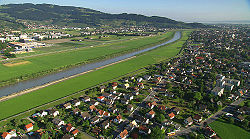Lustenau
| Lustenau | ||
|---|---|---|
 |
||
|
||
| Location within Austria | ||
| Coordinates: 47°25′47″N 09°39′35″E / 47.42972°N 9.65972°ECoordinates: 47°25′47″N 09°39′35″E / 47.42972°N 9.65972°E | ||
| Country | Austria | |
| State | Vorarlberg | |
| District | Dornbirn | |
| Government | ||
| • Mayor | Mag. Dr. Kurt Fischer (ÖVP) | |
| Area | ||
| • Total | 22.55 km2 (8.71 sq mi) | |
| Elevation | 404 m (1,325 ft) | |
| Population (1 January 2016) | ||
| • Total | 22,214 | |
| • Density | 990/km2 (2,600/sq mi) | |
| Time zone | CET (UTC+1) | |
| • Summer (DST) | CEST (UTC+2) | |
| Postal codes | 6890, 6893 | |
| Area code | 05577 | |
| Vehicle registration | DO | |
| Website | www.lustenau.at | |
Lustenau ([ˈluːstənaʊ]; Alemannic: Luschnou) is a town in the Austrian state of Vorarlberg in the district of Dornbirn. It lies on the River Rhine, which forms the border with Switzerland. Lustenau is Vorarlberg's fourth largest town.
Until 1830, Lustenau was an independent county reigned by the counts of Waldburg-Zeil-Lustenau-Hohenems. After 1830 it became part of Austria. The name Lustenau derives from a document signed by the Carolingian king Charles the Fat with the title "Lustenauua curti regali", meaning "Royal Court of Lustenau"
Lustenau is served by a railway station, on the Vorarlberg Railway which runs between St. Margrethen in Switzerland and Bregenz. It is also the headquarters of the International Rhine Regulation Railway, a preserved industrial railway that was formerly used in the management of the River Rhine.
Lustenau has a long and successful history in sports. The town's two football teams, SC Austria Lustenau and FC Lustenau, play in major Austrian football leagues. The well-known and successful skier, Marc Girardelli, was born in Lustenau, and the Lustenau ice-hockey team, EHC Lustenau, is part of the Austrian National League. The town used to be a major centre of the embroidery industry in the past and is now a centre for the new technologies industry.
...
Wikipedia



